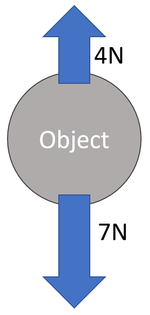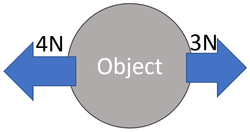Difference between revisions of "Resultant Force"
(→About Resultant Forces) |
|||
| Line 35: | Line 35: | ||
: When [[force]]s act in the same direction their [[magnitude]]s are added together. | : When [[force]]s act in the same direction their [[magnitude]]s are added together. | ||
: When [[force]]s act along the same line but in opposite directions; one is [[Subtraction|subtracted]] from the other. | : When [[force]]s act along the same line but in opposite directions; one is [[Subtraction|subtracted]] from the other. | ||
| + | : When [[force]]s are at [[Right Angle|right angles]] to one another they can be added using [[Pythagoras Theorem|Pythagoras theorem]] to find the [[magnitude]] of the '''resultant force''' and then [[trigonometry]] can be used to find the direction of the '''resultant force'''. | ||
Revision as of 12:49, 5 February 2019
Contents
Key Stage 3
Meaning
The Resultant Force is the overall force on an object.
About Resultant Forces
- A resultant force can be calculated by taking forces that act in opposite directions and subtracting one from the other.
Key Stage 4
Meaning
The resultant force is the sum of all forces acting on an object.
About Resultant Forces
- When forces act in the same direction their magnitudes are added together.
- When forces act along the same line but in opposite directions; one is subtracted from the other.
- When forces are at right angles to one another they can be added using Pythagoras theorem to find the magnitude of the resultant force and then trigonometry can be used to find the direction of the resultant force.


